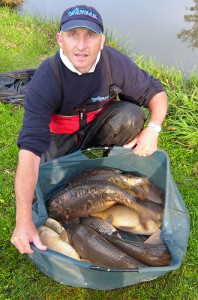Dead maggots can really give you an edge and can be used to great effect for all sorts of species at this time of year. England ace, Stu Conroy, uses a lot of these inert grubs and shares a great tip on preparing them.
A lifeless hook bait not only reduces the chance of masking the hook point but is less likely to appeal to small nuisance fish as much as live maggots would do. They also act as a great alternative holding bait when added to groundbait. Dead maggots are also excellent for ‘balling in’ mixes as they don’t crawl out of pre-formed balls, but stay in the mix when it breaks down on the bottom.
I have used dead maggots many times when fishing for skimmers and bream on the feeder, and on venues such as the Gloucester Canal or Porth Reservoir in Cornwall they can be deadly (pardon the pun!). However, it’s their appeal to large, wary commercial carp that I would like to focus on. These are the fish that come into the margins to feed, often for the last hour of the session. They are suckers for dead maggots as they are used to finding large amounts of them when match and pleasure anglers alike toss in their unwanted bait after fishing (often down the margins). So, a 10lb carp possibly associates dead maggots with safety and an easy meal.
At this time of year carp can eat as many maggots as you can feed them, thus making it very difficult to ruin your swim. Many of the maggots you feed, though, will get get eaten by nuisance silvers, so to feed three or four swims heavily you would need in excess of a gallon for a five-hour session. This is where feeding inert maggots comes in. By setting ‘traps’ and cupping in large quantities periodically, you can concentrate on other areas and prime a big fish line for the last hour.
Over the years I’ve had many ways of ‘doing’ dead maggots with mixed results. Freezing them for a couple of days was probably best but on the down side they can take ages to defrost and go a black, manky colour as the session goes on. Boiling water is OK for small amounts (especially just for the hook), but if applied directly they can easily turn a horrible hard white.
 So, after feeling frustrated with these methods I tried liquidising them! I found on a slow speed my blender didn’t chop them, it just killed them. By doing it this way I could vary the volume of how many I needed and they were the best, softest maggots I had ever seen! Three pints of dead maggots on the morning of a match literally takes me five minutes to prepare. Awesome!
So, after feeling frustrated with these methods I tried liquidising them! I found on a slow speed my blender didn’t chop them, it just killed them. By doing it this way I could vary the volume of how many I needed and they were the best, softest maggots I had ever seen! Three pints of dead maggots on the morning of a match literally takes me five minutes to prepare. Awesome!
So, if you have an old liquidiser or blender in your kitchen cupboard that doesn’t get used (I highly advise you ask your partner first!) give it a go and join the Dead Maggot Society!

